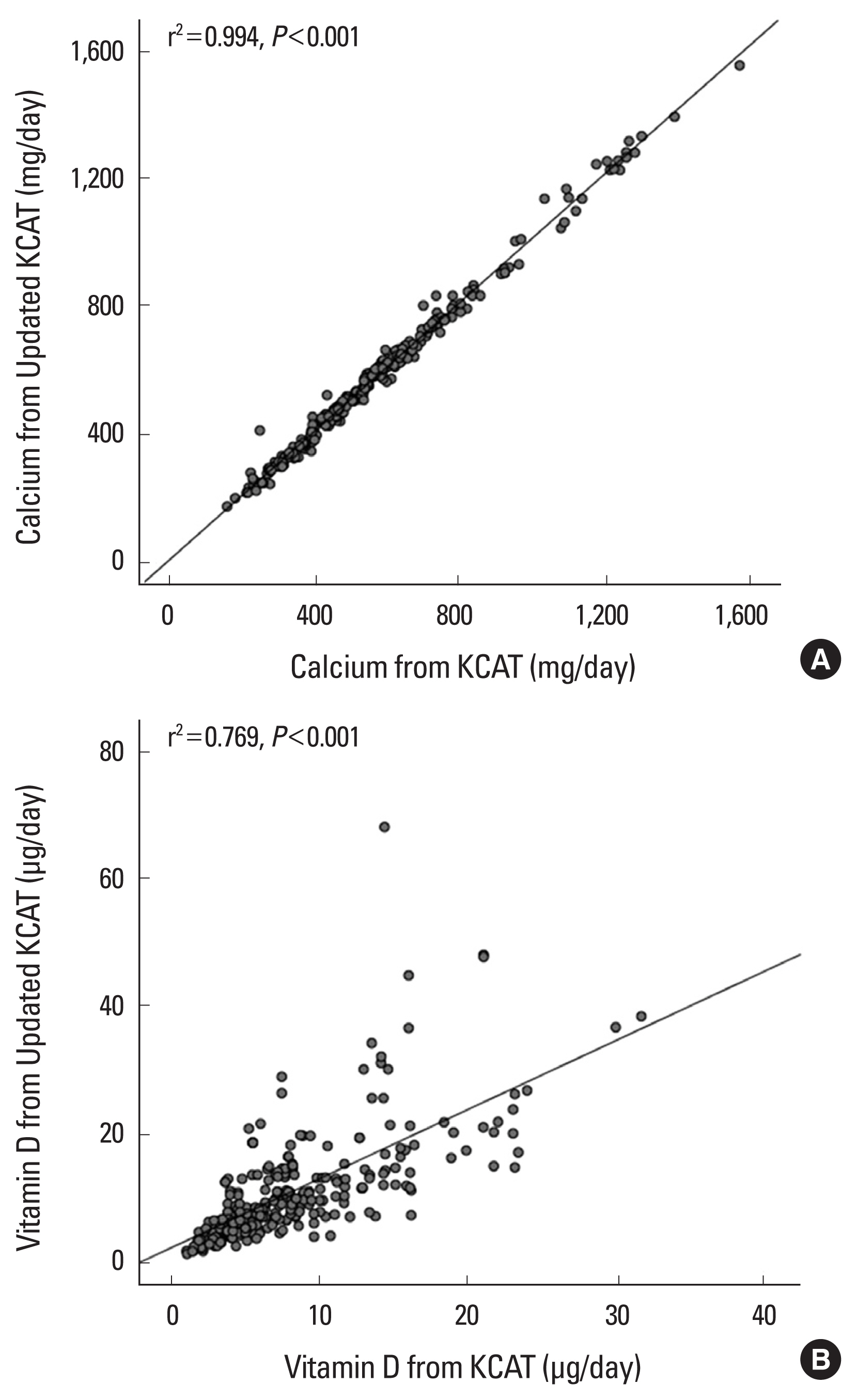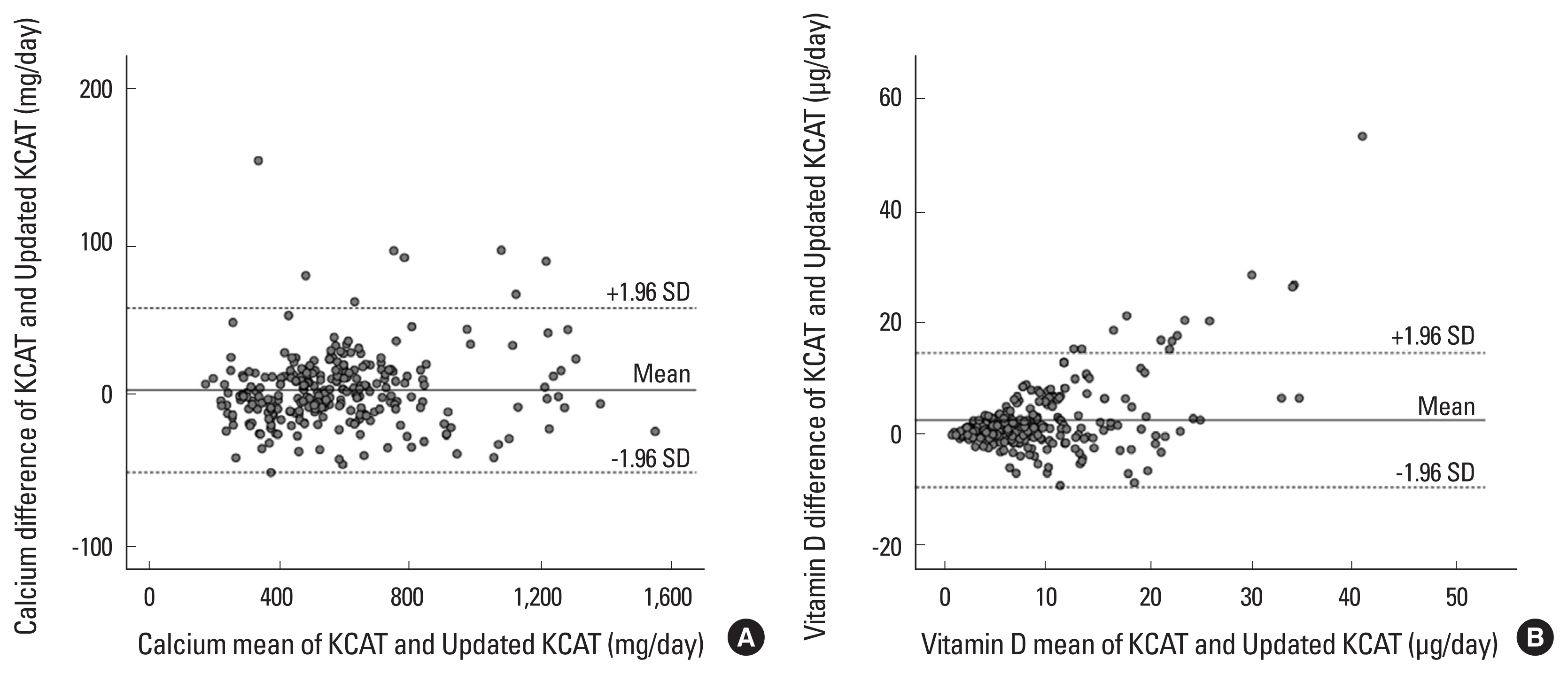1. In: Rodrigo L, editors. Osteoporosis: Recent advances, new perspectives and applications. London, UK: IntechOpen; 2021.
2. Ministry of Health & Welfare and Family Affairs. Korea Center for Disease Control and Prevention. Korea health statistics 2008: Korea national health and nutrition examination survey (KNHANES IV-2). Seoul: Korea Center for Disease Control and Prevention; 2009.
7. Ministry of Health and Welfare. The Korean Nutrition Society. Dietary reference intakes for Koreans 2015. Sejong: Ministry of Health and Welfare; 2015.
14. Park Y, Kim SH, Lim YT, et al. Validation of a new food frequency questionnaire for assessment of calcium and vitamin d intake in korean women. J Bone Metab 2013;20:67-74.
https://doi.org/10.11005/jbm.2013.20.2.67.



15. Ministry of Health & Welfare, Korea Centers for Disease Control and Prevention Korea health statistics. 2013 Korea national health and nutrition examination survey (KNHANES VI-1). Sejong: Korea Center for Disease Control and Prevention; 2014.
16. Ministry of Health & Welfare, Korea Centers for Disease Control and Prevention. Korea health statistics 2014 Korea national health and nutrition examination survey (KNHANES VI-2). Sejong: Korea Center for Disease Control and Prevention; 2015.
17. Ministry of Health and Welfare, Korea Disease Control and Prevention. Korea health statistics 2015: Korea national health and nutrition examination survey (KNHANES VI-3). Sejong: Korea Center for Disease Control and Prevention; 2016.
18. Ministry of Health and Welfare, Korea Centers for Disease Control and Prevention Korea health statistics. 2016 Korea national health and nutrition examination survey (KNHANES VII-1). Sejong: Korea Centers for Disease Control and Prevention; 2017.
19. Ministry of Health and Welfare, Korea Disease Control and Prevention Agency. Korea health statistics 2017: Korea national health and nutrition examination survey (KNHANES VII-2). Sejong: Korea Center for Disease Control and Prevention; 2018.
20. Ministry of Health and Welfare, Korea Disease Control and Prevention. Korea health statistics 2018: Korea national health and nutrition examination survey (KNHANES VII-3) Sejong: Korea: Centers for Disease Control and Prevention; 2019.
22. Taylor R. Interpretation of the correlation coefficient: a basic review. J Diagn Med Sonogr 1990;6:35-9.

23. Cohen J. Weighted kappa: nominal scale agreement with provision for scaled disagreement or partial credit. Psychol Bull 1968;70:213-20.
https://doi.org/10.1037/h0026256.


24. Altman DG, Bland JM. Measurement in medicine: the analysis of method comparison studies. J R Stat Soc Series B Statistician 1983;32:307-17.

25. Faul F, Erdfelder E, Lang AG, et al. G*Power 3: a flexible statistical power analysis program for the social, behavioral, and biomedical sciences. Behav Res Methods 2007;39:175-91.
https://doi.org/10.3758/bf03193146.


26. Itkonen ST, Erkkola M, Skaffari E, et al. Development and validation of an interview-administered FFQ for assessment of vitamin D and calcium intakes in Finnish women. Br J Nutr 2016;115:1100-7.
https://doi.org/10.1017/s0007114515005474.


27. Montomoli M, Gonnelli S, Giacchi M, et al. Validation of a food frequency questionnaire for nutritional calcium intake assessment in Italian women. Eur J Clin Nutr 2002;56:21-30.
https://doi.org/10.1038/sj.ejcn.1601278.


28. Chee WS, Suriah AR, Zaitun Y, et al. Dietary calcium intake in postmenopausal Malaysian women: comparison between the food frequency questionnaire and three-day food records. Asia Pac J Clin Nutr 2002;11:142-6.
https://doi.org/10.1046/j.1440-6047.2002.00276.x.


29. Osowski JM, Beare T, Specker B. Validation of a food frequency questionnaire for assessment of calcium and bone-related nutrient intake in rural populations. J Am Diet Assoc 2007;107:1349-55.
https://doi.org/10.1016/j.jada.2007.05.012.


30. Uenishi K, Ishida H, Nakamura K. Development of a simple food frequency questionnaire to estimate intakes of calcium and other nutrients for the prevention and management of osteoporosis. J Nutr Sci Vitaminol (Tokyo) 2008;54:25-9.
https://doi.org/10.3177/jnsv.54.25.


31. Khan NC, Mai le B, Hien VT, et al. Development and validation of food frequency questionnaire to assess calcium intake in postmenopausal Vietnamese women. J Nutr Sci Vitaminol (Tokyo) 2008;54:124-9.
https://doi.org/10.3177/jnsv.54.124.


33. Severo M, Lopes C, Lucas R, et al. Development of a tool for the assessment of calcium and vitamin D intakes in clinical settings. Osteoporos Int 2009;20:231-7.
https://doi.org/10.1007/s00198-008-0647-6.


34. Magkos F, Manios Y, Babaroutsi E, et al. Development and validation of a food frequency questionnaire for assessing dietary calcium intake in the general population. Osteoporos Int 2006;17:304-12.
https://doi.org/10.1007/s00198-004-1679-1.


35. Bhavadharini B, Dehghan M, Mente A, et al. Association of dairy consumption with metabolic syndrome, hypertension and diabetes in 147 812 individuals from 21 countries. BMJ Open Diabetes Res Care 2020;8:e000826.
https://doi.org/10.1136/bmjdrc-2019-000826.

36. Wang Y, Li S. Worldwide trends in dairy production and consumption and calcium intake: is promoting consumption of dairy products a sustainable solution for inadequate calcium intake? Food Nutr Bull 2008;29:172-85.
https://doi.org/10.1177/156482650802900303.

37. Adolphi B, Scholz-Ahrens KE, de Vrese M, et al. Short-term effect of bedtime consumption of fermented milk supplemented with calcium, inulin-type fructans and caseinphosphopeptides on bone metabolism in healthy, postmenopausal women. Eur J Nutr 2009;48:45-53.
https://doi.org/10.1007/s00394-008-0759-y.

38. Varenna M, Binelli L, Casari S, et al. Effects of dietary calcium intake on body weight and prevalence of osteoporosis in early postmenopausal women. Am J Clin Nutr 2007;86:639-44.
https://doi.org/10.1093/ajcn/86.3.639.

39. Hong MH, Oh SY. Within-and between-person variation in nutrient intakes by the Korean elderly. Korean J Community Nutr 1998;3:423-9.
40. Kim SY, Jung K, Lee B, et al. A study of the dietary intake status and one portion size of commonly consumed food and dishes in Korean elderly women. Korean J Community Nutr 1997;2:578-92.
41. Lee HS, Chang MJ. Effect of family type on the nutrient intake and nutritional status in elderly women. J Korean Soc Food Sci Nutr 1999;28:934-41.
42. Kim SW, Bae KH, Seo JB, et al. Association between household size, residential area, and osteoporosis: analysis of 2008 to 2011 Korea National Health and Nutrition Examination Survey. Korean J Intern Med 2016;31:712-21.
https://doi.org/10.3904/kjim.2015.274.

43. Korea Rural Economic Institute. 2019 Food balance sheet. Naju: Korea Rural Economic Institute; 2020.












 PDF Links
PDF Links PubReader
PubReader ePub Link
ePub Link Full text via DOI
Full text via DOI Full text via PMC
Full text via PMC Download Citation
Download Citation Print
Print



